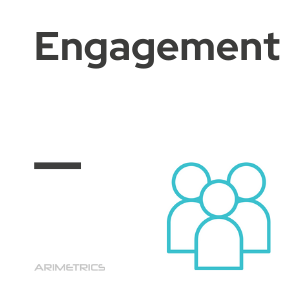
Definition:
Engagement refers to the ability of a brand to generate engagement with its consumers through persistent and stable relationships. The better our relationship with the client, the better we can get to know them and provide a differential value that improves our positioning and perception as a brand.
Engagement is an effect, a reaction, a connection, a response and/or an experience of customers with each other, with a company or with a brand. The initiative of engagement or commitment can be either of the consumer or of the company, and the means of this can be online or offline.
The importance of engagement
Engagement is a connection between consumers and organizations through various communication activities, established by the organization or company. There is direct communication with customers so that they are involved in the engagement process, giving them control in exchange for their attention, to increase brand awareness and loyalty, and to gain popularity with word of mouth.
These exchanges increase the success of marketing campaigns, adding value to the brand and/or product or service and improving customer service.
Engagement measures shared posts, interactions, and comments with social profiles. Within the three main social networks can be analyzed in different ways.
- Facebook: Interactions, followers and likes.
- Instagram: Only stays with followers and likes.
- Twitter: retweets and followers.
How to achieve it
To achieve lasting and stable relationships we have to know our customers and connect with them, for this we must:
- Interact with your consumers: very important that our customers feel cared for and understood, for this we have at our disposal multiple resources that allow us to talk with them, read and respond to their criticisms and evaluations, solve their doubts, etc.
- Produce differential content: through quality and unique content we can generate interest in our users and in this way viralize our brand, increase the number of interactions and ultimately get a greater number of “engaged” users.
- Having brand personality: working our own identity as a brand, through a unique, solid image and will encourage the client to feel identified with it, generating a feeling of deep engagement.
- Empathize: it is not only about relating to your client, but doing it individually, putting yourself in the place of the same so that it feels understood and fulfilled.
- Personalize: make the customer feel unique, that feeling of exclusivity is undoubtedly one of the most powerful tools when it comes to generating engagement. Reward customer loyalty, offer exclusive content, etc.
Phases of Engagement Marketing
It is about building brand relationships with the customer. This is worked through the process: visibility, attraction, interest, relationship, commitment and growth.
- Visibility: To generate engagement, the main thing is to get them to see you. It is essential to know where your audience is, what they are looking for to offer your content on this channel.
- Attraction: The content must be useful and relevant. Once your work is in view of your audience, it’s time to offer them something that is valuable for users to interact with.
- Interest: After you have grasped your attraction it is time to generate interest. Continue to offer relevant content to create engagement.
- Relation: Thanks to external tools such as CRM you can combine sales strategy with marketing. This will increase productivity.
- Commitment Sale: The user achieves the goal you had set. Here customer service becomes relevant.
- Growth: It consists of getting customers to become prescribers. Customers should promote the acquisition of new users.
Examples of Engagement Marketing
- Campaigns that generate “brand feeling”:companies such as Gillette, Mutua Madrileña or Always are clear examples of campaigns in which a feeling of belonging and pride is evoked, generating strong emotional bonds of customers with the brand.
- Encourage customer participation,through social media, blogs, apps or communities, through them the client feels that he is part of a collective and develops a greater sense of belonging.
- Provide valuable content for the client: the fact of generating a surplus value, either through the characteristics of the product or any extra service that the company can provide, makes the client feel valued and remain faithful to our brand.
